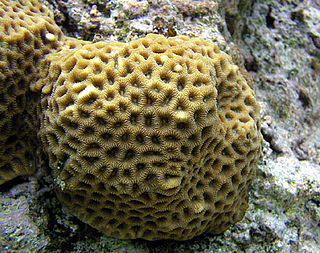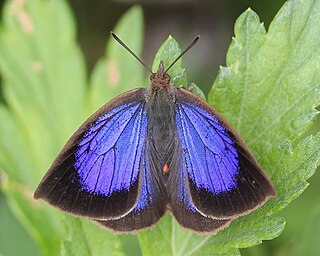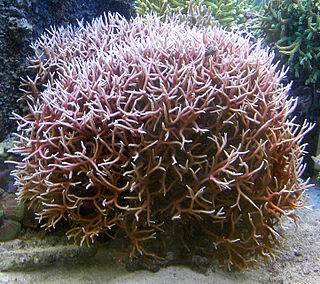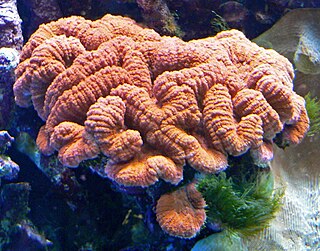
Henry Quelch was one of the first Marxists and founders of the social democratic movement in Great Britain. He was a socialist activist, journalist and trade unionist. His brother, Lorenzo "Len" Quelch, was also a socialist activist, while his son, Tom Quelch, achieved note as a prominent communist activist.

Brain coral is a common name given to various corals in the families Mussidae and Merulinidae, so called due to their generally spheroid shape and grooved surface which resembles a brain. Each head of coral is formed by a colony of genetically identical polyps which secrete a hard skeleton of calcium carbonate; this makes them important coral reef builders like other stony corals in the order Scleractinia. Brain corals are found in shallow warm water coral reefs in all the world's oceans. They are part of the phylum Cnidaria, in a class called Anthozoa or "flower animals". The lifespan of the largest brain corals is 900 years. Colonies can grow as large as 1.8 m (6 ft) or more in height.

Justice was the weekly newspaper of the Social Democratic Federation (SDF) in the United Kingdom.

John Anthony Quelch CBE is a British-American academic and professor. Quelch is the executive vice chancellor of Duke Kunshan University in Kunshan, China. He is the former dean of the University of Miami School of Business at the University of Miami in Coral Gables, Florida from 2017 to 2022.

Arhopala is a very large genus of gossamer-winged butterflies (Lycaenidae). They are the type genus of the tribe Arhopalini. In the relatively wide circumscription used here, it contains over 200 species collectively known as oakblues. They occur from Japan throughout temperate to tropical Asia south and east of the Himalayas to Australia and the Solomon Islands of Melanesia. Like many of their relatives, their caterpillars are attended and protected by ants (myrmecophily). Sexual dichromatism is often prominent in adult oakblues.

The Fungiidae are a family of Cnidaria, commonly known as mushroom corals or plate corals. The family contains thirteen extant genera. They range from solitary corals to colonial species. Some genera such as Cycloseris and Fungia are solitary organisms, Polyphyllia consists of a single organism with multiple mouths, and Ctenactis and Herpolitha might be considered as solitary organisms with multiple mouths or a colony of individuals, each with its separate mouth.

The Ceratobatrachidae are a family of frogs found in the Malay Peninsula, Borneo, the Philippines, Palau, Fiji, New Guinea, and the Admiralty, Bismarck, and Solomon Islands.

Goniopora, often called flowerpot coral, is a genus of colonial stony coral found in lagoons and turbid water conditions. Goniopora have numerous daisy-like polyps that extend outward from the base, each tipped with 24 stinging tentacles which surrounds a mouth.

Stylaster is a genus of hydroids in the family Stylasteridae.

Plumularia is a genus of hydrozoans in the family Plumulariidae.

Seriatopora is a genus of colonial stony corals in the family Pocilloporidae. They are commonly known as needle corals, birdsnest corals or finger corals. They are native to the Red Sea, the Indo-Pacific region and some parts of the Central Pacific Ocean.

Lobophylliidae is a family of large polyp stony corals. The family was created in 2009 after a revision of the "robust" families of Faviidae, Merulinidae, Mussidae and Pectiniidae, which had been shown to be polyphyletic. The family Lobophylliidae was formed out of the Indo-Pacific species that had traditionally been included in Mussidae, and some of the species which had previously formed Pectiniidae, the remaining species from Pectiniidae having been merged into Merulinidae. The type genus is Lobophyllia.

Stylophora is a genus of colonial stony corals in the family Pocilloporidae. They are commonly known as cat's paw corals or birdsnest corals. They are native to the Red Sea, the Indo-Pacific region and eastwards as far as the Pitcairn Islands.
Cyrtogrammomma is a monotypic genus of South American brushed trapdoor spiders containing the single species, Cyrtogrammomma monticola. It was first described by Reginald Innes Pocock in 1895, and has only been found in Guyana.
The 1959–60 season was Burnley Football Club's 61st season in the Football League, and their 13th consecutive campaign in the First Division, the top tier of English football. The team, and their manager Harry Potts, endured a tense season in which Tottenham Hotspur and Wolverhampton Wanderers were the other contenders for the league title. Burnley won their second First Division championship, and their first since 1920–21, on the last matchday with a 2–1 victory at Manchester City; they had not topped the table until the last match was played out. Only two players—Alex Elder and Jimmy McIlroy—had cost a transfer fee, while the others were recruited from Burnley's youth academy. With 80,000 inhabitants, the town of Burnley became one of the smallest to have hosted an English first-tier champion. In the FA Cup, Burnley reached the sixth round before being defeated by local rivals Blackburn Rovers after a replay. Burnley won the local Lancashire Cup for the fifth time in their history after defeating Manchester United in the final. After the regular season ended, the Burnley squad travelled to the United States to participate in the first edition of the International Soccer League.

Goniopora tenuidens is a species of colonial stony coral in the family Poritidae. It occurs in shallow water in the tropical Indo-Pacific region. The International Union for Conservation of Nature has assessed its conservation status as being of "least concern".

Zygophylax is a genus of cnidarians belonging to the family Zygophylacidae.

Physogyra is a genus of cnidarians belonging to the family Plerogyridae.

Sandalolitha is a genus of cnidarians belonging to the family Fungiidae.

















